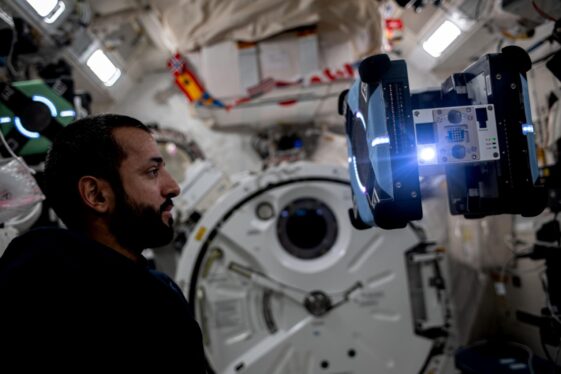NASA Seeks Input for Astrobee Free-flying Space Robots

NASA
NASA is seeking input from American companies for the operation and use of a system of free-flying robots aboard the International Space Station as the agency continues to foster scientific, educational, and technological developments in low Earth orbit for the benefit of all.
The colorful, cube-shaped robots – named “Bumble,” “Honey,” and “Queen” – are part of the Astrobee system helping astronauts and researchers perform technology demonstrations, scientific research, and STEM (science, technology, engineering and mathematics) activities in the unique environment of space since 2018.
“Dozens of institutions collaborate with NASA to use the Astrobee system to test new hardware and software technologies,” said Jose Benavides, project manager for the Astrobee facilities at NASA’s Ames Research Center in California’s Silicon Valley, where the system was designed and built. “I’m excited to hear how respondents think Astrobee can continue to advance robotics in space.”
NASA issued a Request for Information to inform strategic planning, inviting industry to provide information to help shape the maturation of robotics in zero gravity to achieve the greatest scientific and exploration value. Responses are due Sept. 27, 2024. To learn more about the Request for Information, visit:
https://sam.gov/opp/7893fe01e7bf4ae69029b5d8915e62c5/view

The battery-powered robots in the Astrobee system fly around the space station’s modules using electric fans for propulsion and “see” their surroundings using lights, cameras, and other sensors. They have interchangeable “arms” that provide ways for the robots to hold objects or keep steady for tasks requiring stability, and magnets to ensure they stay securely docked when recharging.
Working autonomously, or via remote control by astronauts, flight controllers, or researchers on the ground, the robots can be used to off-load time-consuming tasks. For instance, the robots can work independently or collaboratively to assist with routine chores like space station monitoring, maintenance, inventory, experiment documentation, or moving cargo throughout the station. This allows astronauts more time to tackle complex work that only humans can perform.
Astrobee’s versatile design has allowed thousands of hours of testing on hundreds of microgravity experiments. Many have involved astronauts, but the facility also is regularly used by researchers and student teams across the world competing for the opportunity to run their programs on the robots in space.
Further developing human-robotic technology will pave the way for future crewed and uncrewed spacecraft maintenance and exploration tasks done by robots both off-planet and in deep space"

Jonathan Barlow
Astrobee Project Manager
For example, NASA’s ISAAC (Integrated System for Autonomous and Adaptive Caretaking) project, used the Astrobees to study how robots could assist spacecraft, vehicle systems, and ground operators. The technology could help NASA use robot caretakers for critical spacecraft in the agency’s Moon-to-Mars plans, including the Gateway lunar space station and Mars transit habitat vehicle, especially during the months-long periods when these spacecraft will be uncrewed.
“Our ISAAC work has proved out its technology in a high-fidelity space environment because of the ready availability of the capable Astrobee robots,” said Trey Smith, project manager for ISAAC at NASA Ames.
The project demonstrated using multiple Astrobees to autonomously collect the first robot-generated survey of a spacecraft interior. Other ISAAC firsts include the first use of a robot to locate the source of a sound in space, in collaboration with the Bosch USA SoundSee payload team, and the first time robots navigated between modules of a space station. Future robots could use ISAAC technology to transfer cargo between space vehicles or respond to a time-critical fault like a leak due to a micrometeoroid impact, all without human assistance.
“With Astrobee, we’ve learned about flying multiple robots in space alongside humans,” said Jonathan Barlow, project manager for Astrobee at NASA Ames. “Further developing human-robotic technology will pave the way for future crewed and uncrewed spacecraft maintenance and exploration tasks done by robots both off-planet and in deep space.”
The Astrobee Facility, operated out of NASA’s Ames Research Center, provides a free-flying robotic system for space station research and STEM outreach. NASA’s Game Changing Development Program, part of the agency’s Space Technology Mission Directorate, funded Astrobee. NASA’s International Space Station Utilization Office provides ongoing funding.

https://www.nasa.gov/technology/robotics/nasa-seeks-input-for-astrobee-free-flying-space-robots/





